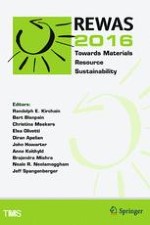Topics covered in this collection include the following: •Enabling & Understanding Sustainability - Ferrous & Non-ferrous Metals Processing •Understanding & Enabling Sustainability - (Rechargeable) Batteries •Enabling & Understanding Sustainability - Rare Earth Element Applications •Enabling & Understanding Sustainability - Building Materials & Slag Valorisation •Designing Materials and Systems for Sustainability •Understanding & Enabling Sustainability - Light Metals Recycling & Waste Valorisation •Understanding & Enabling Sustainability - Education Research Innovation I •Understanding & Enabling Sustainability - Education Research Innovation II + Electronic Equipment
